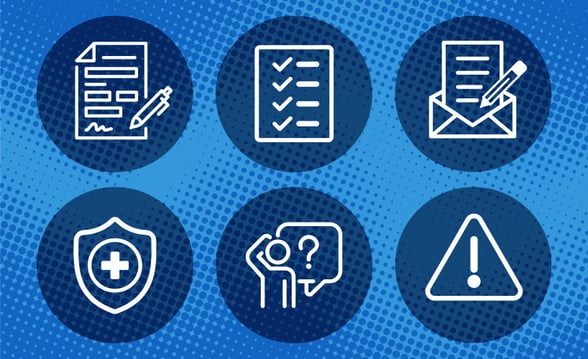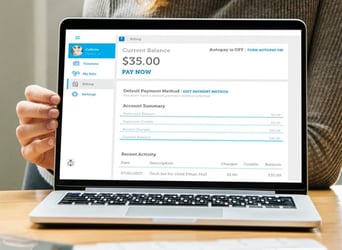
You don’t need to be told how chaotic the day can get in a childcare center; you live it. Between snack-time meltdowns and surprise licensing visits, writing a handbook for childcare might feel like a luxury.
However, if you're constantly answering the same questions or mediating preventable misunderstandings, the lack of a childcare parent handbook is costing you. Clear childcare center policies and procedures don’t just help families; they help you breathe.
That's why we've created this guide to walk you through the must-have sections, practical tips and tools to create a handbook that works for everyone involved.
Table of Contents
- What Is a Childcare Parent Handbook?
- FREE Childcare Parent Handbook Template
- How to Distribute and Use the Handbook
- Key Sections to Include in a Childcare Parent Handbook
- How Vanco Supports Childcare Centers
- FAQs
- Final Thoughts
- Get More! 100+ FREE Templates to Make Running Your Daycare Easier
What Is a Childcare Parent Handbook?

A childcare parent handbook serves as your family handbook for early education, laying out everything from tuition and payment agreement forms to daycare policies and procedures.
Think of it as your go-to childcare enrollment guide and preschool family handbook, all wrapped into one. By creating a professional childcare handbook, you set clear childcare expectations for families before the first day of class.
How It Benefits Both Providers and Families
First, you give your staff a consistent playbook for communication between providers and parents, reducing misunderstandings. You also set clear childcare expectations for families, so everyone knows drop-off times, meal procedures and how to handle emergencies.
A solid family handbook template for early learning helps in building parent trust in early childhood education by showing you’ve thought through every detail:
- Tuition schedules
- Tuition and payment agreement forms
- The way you share sick-child policies
Plus, when turnover among child care programs is higher than the median for an occupation, a handbook that families actually use can take one more task off your staff’s plate and help prevent burnout.
Common Uses: Enrollment, Onboarding, Communication
Use this handbook during enrollment to share childcare center policies and procedures, from meals to nap routines. At orientation, your family handbook template for early learning lays out routines and sets boundaries in childcare settings without sounding robotic.
Throughout the year, it becomes a reference point for sharing policy updates with families, whether you tweak the illness policy or adjust hours for holidays.
Additionally, when parents ask, “What’s the procedure for signing release forms?” you point them to the section on parent communication in childcare and daycare policies and procedures. No reinvention is required.
FREE Childcare Parent Handbook Template
If you're not using a childcare parent handbook, you're working harder than you need to. A solid family handbook for early education doesn't just check a licensing box; it helps you stop repeating yourself 17 times a day about nap mats and pickup times.
The reality is that a good handbook sets clear childcare expectations for families so you’re not constantly putting out fires that could’ve been avoided.
We’ve created a free family handbook template for early learning that you can download, customize and make your own. It’s designed to support everything from parent onboarding in daycare to updating policies with minimal stress. Whether you're running a small center or managing multiple classrooms, this template is structured for clarity, something you and your families will appreciate.
Resources for Customizing the Handbook
Let’s talk about state rules. Not fun, but necessary. Every state has its own childcare center policies and procedures, especially when it comes to child-to-caregiver ratios and health protocols. You must align your preschool family handbook with those state-specific rules if you want to stay compliant.
That’s why we compiled a complete reference list in our companion guide. Now, you don’t have to bounce between 12 websites to find out what your licensing board expects. The list covers quality improvement guidelines by state, essential compliance points and links to official documents.
Use it alongside the handbook template to make informed edits around areas like tuition and payment agreement forms, setting boundaries in childcare settings and communication between providers and parents. You’ll also see how sharing policy updates with families becomes a whole lot easier when you've got this structure in place.
How to Distribute and Use the Handbook
You know that feeling when you’ve explained your daycare policies and procedures for the fifth time in one week and still get another “but I didn’t know” email? That’s precisely why your childcare parent handbook must be more than a document collecting dust.
Whether you hand out printed copies in bright folders or email a PDF as part of your parent onboarding in daycare, make sure families actually see and use it. During orientation, don’t just mention it; walk families through it. This moment is where your family handbook for early education sets the tone for everything that follows.
Talk openly about your childcare center policies and procedures, explain what you expect and highlight the tuition and payment agreement forms (yes, the part they tend to skim).
When issues arise, and they will, this is your go-to. Refer to it during parent conversations. It protects you and builds the structure for setting boundaries in childcare settings. Plus, when it’s time to update it (and you should, annually), get everyone to sign a new acknowledgement.
Key Sections to Include in a Childcare Parent Handbook
If you’ve ever had to explain your childcare center policies and procedures more than once to the same parent, you already know why a solid childcare parent handbook isn’t just helpful. It’s necessary.
It’s your go-to reference point for everything from your philosophy to your snow-day protocol. If you're putting one together (or fixing one that no one reads), knowing precisely what sections to include can save your sanity and keep expectations clear.
Welcome Letter and Mission Statement
Your preschool family handbook should open with a welcome that sounds like you, not a cut-and-paste corporate message. Introduce yourself. Talk about your center’s “why.” This section is your chance to let parents know what you believe in, how you care for children and why your team shows up every day (even to a room full of toddlers and a pasta lunch).
This section sets the tone for your childcare expectations for families and shows you're not just watching kids; you’re cultivating growth.
Program Overview
Parents don’t want to guess what you offer. They want clear information about the age groups you serve, your daily hours, your curriculum approach and how that translates into real activities. Whether you're Reggio-inspired, play-based or somewhere in between, this is the place to put it.
It also helps manage your parent onboarding in daycare because families come in knowing what you do, and what you don’t.
Enrollment and Withdrawal Policies
Here’s where it gets real. This section should walk parents through your registration process and required documents. No one wants last-minute scrambles for immunization records. It should also include your policy on withdrawals (because, yes, people will leave mid-year) and how much notice you expect.
You're not just writing a handbook for childcare here; you’re making sure everyone’s on the same page from day one.
Tuition and Payment Policies
Let’s talk about money. If there’s one thing that causes conflict, it’s payment issues. Include your fee structure, due dates, late payment penalties and refund policy. Be specific.
Putting tuition and payment agreement forms up front helps avoid those awkward conversations later. It also takes the burden off your staff when policies are clearly spelled out.
Daily Schedule and Sample Routine
You know that structure matters; kids thrive on it. Parents do too. Spell out your drop-off and pick-up windows. What does a typical day look like in your center? Meals, naps, outside time, enrichment — put it all in.
This approach helps with parent communication in childcare because when parents know what to expect, they’re less likely to worry (or text you midday asking if their child has eaten yet).
Health and Safety Policies
This one’s big. Illness policies, required immunizations, medication administration and emergency contacts all belong here. Parents need to know when to keep their child home and what happens if someone gets sick at school.
It’s also where your childcare center policies and procedures should intersect with local or state regulations. Don’t skip details like your protocol for accidents or allergies.
Discipline and Behavior Expectations
Yes, toddlers will throw blocks and push. That’s why you need this section. Share your approach to behavior support, positive reinforcement, redirection, logical consequences and how you involve parents.
This section is part of setting boundaries in childcare settings and ensures your team isn’t left to interpret discipline on the fly. It also helps parents understand the process and how they can support it at home.
Communication Methods
Parents want updates. However, you don’t need 10 platforms to do it. Just explain what you use — apps, emails, newsletters, maybe a bulletin board. Include how often families can expect communication and how to reach staff with questions or concerns.
This section ensures consistent communication between providers and parents, which is the backbone of strong relationships and smoother transitions.
Clothing, Supplies and Food Requirements
You know what’s worse than a child showing up in sandals during outdoor play? When they do it three days in a row. Use this section to explain what children need each day: extra clothes, labeled bottles and specific bedding.
Include food guidelines, allergy protocols and labeling expectations to reinforce families' childcare expectations.
Inclement Weather and Closure Policies
If you’re closing for a snowstorm, parents need to know how you’ll tell them. Whether you follow the school district or have your own criteria, this is where you lay it out. Don’t forget holidays, emergency closures and planned staff days off.
Adding this section reduces the number of “Are you open today?” calls by about 100% — probably more.
Rights and Responsibilities of Families and Staff
This section is the heart of creating a professional childcare handbook. You’re spelling out what’s expected from both sides. Respect, timely pickup, open communication and handling concerns. This approach helps when conflicts pop up (and they will). Parents feel seen, and your staff isn’t guessing how to handle things.
Plus, it supports sharing policy updates with families later on because everyone has agreed to the core values and responsibilities from day one.
How Vanco Supports Childcare Centers

Writing a handbook for childcare can often feel like managing a million little details. That’s where Vanco steps in.
With our tools, you don’t have to handle everything manually. They help you manage everything from tuition and payment agreement forms to tracking late fees, all while ensuring your childcare center policies and procedures are followed.
It’s a serious time-saver, especially when you consider how much higher turnover in child care is than most occupations, and that 46% of professionals cite burnout as a top concern. We can help reduce the burnout.
In addition, Vanco simplifies parent communication in childcare. Our digital tools let you share updates and your family handbook for early education with parents in just a few clicks. Plus, all those parent onboarding steps in daycare become seamless. No more chasing parents for forms or reminders; everything is at their fingertips.
For any childcare provider, these tools are a game-changer. As your center grows, you’ll be able to stay on top of new enrollments and keep your childcare expectations for families precise and up to date. Want to see how it works in action? Check out the video below.

FAQs
How long should a childcare parent handbook be?
The length of your childcare parent handbook depends on the size and scope of your daycare or preschool. Generally, aim for around 10 to 20 pages. A preschool family handbook that’s too long can overwhelm parents, but if it’s too short, it may not fully cover all childcare center policies and procedures. Keep it concise, while ensuring you address everything, from parent onboarding in daycare to tuition and payment agreement forms.
Can I include center-specific rules and policies?
Absolutely! The family handbook for early education is your space to highlight any center-specific rules and policies. This is especially important for establishing clear childcare expectations for families. Whether it’s about nap times, food allergies or pick-up procedures, make sure your policies are crystal clear so everyone is on the same page from day one.
How do I keep families accountable to the handbook?
One key to keeping families accountable is to make parent communication in childcare a regular activity. At the start, you can ask parents to sign an acknowledgment form. Then, you should share policy updates with families regularly to keep them up to date on any changes. A well-written childcare parent handbook serves as a solid foundation for maintaining this relationship.
Should I offer translations for multilingual families?
Yes, offering translations for multilingual families can help ensure that every parent is on the same page, no matter their language. A family handbook template for early learning should be accessible to all families in your care. This aspect is part of building parent trust in early childhood education, showing that you value every family’s understanding of your policies.
How often should I update the parent handbook?
You should revisit and update your childcare parent handbook at least once a year. However, if something changes, don’t wait for an annual review.
Final Thoughts
Creating a solid childcare parent handbook is more than just checking off a box on your to-do list. It’s about setting clear childcare expectations for families from the start. When you build a comprehensive family handbook for early education, you're not only outlining the rules, you're establishing a foundation of trust.
Parents want to know what’s expected, how things work and how to communicate with you. A well-written preschool family handbook clarifies this and builds confidence in your care.
Incorporating childcare center policies and procedures into your handbook ensures everyone is on the same page: parents, children and staff. By including sections like parent onboarding in daycare or tuition and payment agreement forms, you're making things smoother for everyone involved.
When parents know they can rely on consistent and clear communication, your preschool parent handbook becomes a tool that helps maintain a positive, professional environment. Keep it updated, share it regularly and make it an essential part of every family’s journey with you.
Get More! 100+ FREE Templates to Make Running Your Daycare Easier
We've prepared something special for you — 100+ user-friendly templates to make your essential work a little easier. Because the work you do with children matters so very much, and you deserve the tools you need.
Get the Full Collection with Just 4 Simple Steps: Assembly Required (0 Minutes)
- Step 1: Click the button
- Step 2: Download 100+ ready-to-use templates
- Step 3: Implement immediately
- Step 4: Experience efficient childcare management












